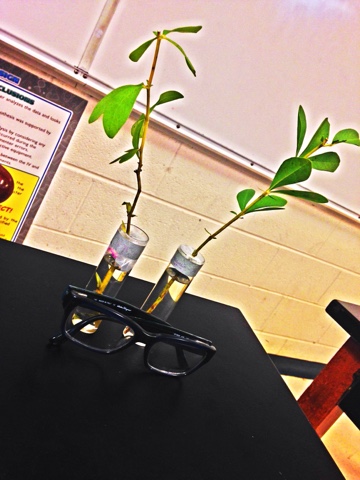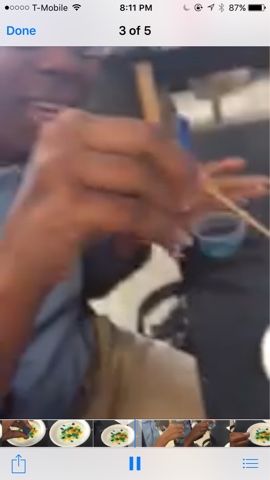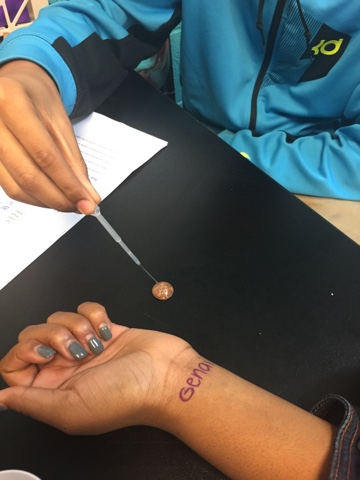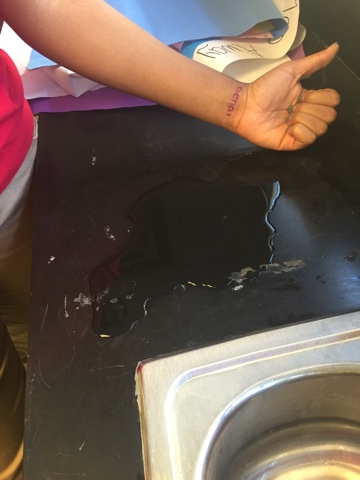Friday, November 27, 2015
Sunday, November 22, 2015
Milk Tye Die Lab (Girnae💙,Destiny💙,Lyric💙)
Q10: Describe what happened when you touched the surface of the milk with the soapy end of the toothpick ?
A: The colors had expanded and made swirls
Q11: What do you think is happening. To the surface tension of the milk when you add the dishwashing soap ?
A: The surface tension is breaking
Q12: If you repeat the experiment using the same milk does it work as well as the first time you did it ?
A: No
Q13: Why do you think this is ?
A: no, because it's already used milk
In this video you will see how the soap reduces the surface tension of the milk by dissolving the fat molecules. The interaction between the two causes a turbulence as the soap breaks down the fat in the milk. The mixture of the two causes the food coloring to swirl.
Water Blog(Tyler Butler)
Cohesion is the sticking together of particles of the same substances
Universal Solvent dissolves more substances
Capillary Action is the ability of a liquid to flow in narrow spaces
Wednesday, November 18, 2015
Water blog : Ashlee Johnson
In the bottom of the plant the water is moving upward with the help of transportation .
Monday, November 16, 2015
Water Blog by Brian Brown
Water tension can cause water to pile on itself allowing it to stick. With the penny lab we wanted to find out the difference in the amount of drops that tension would allow to stick depending on the type of water.
Sunday, November 15, 2015
Water Blog (Wandell Roy)
surface tension: when water molecules stick together to create a layer.
capillary action: the interaction between a solid and a liquid.
adhesion: the action of sticking to a surface.
universal solvent: a solvent that can be used by mostly all solutes.
cohesion: the ability for water molecules to stick to itself.
Water Blog Dakara DaCosta
Adhesion- the action of sticking to a surface.
Cohesion is the bonding together of the same substance. The water in toilet is bonded together and gets flushed and renewed all together.
hydrogen molecules are separated further apart when in liquid form, this causes ice to float in water, causing ice to be less dense.
Water is a universal solvent because it can dissolve any substance. All organisms depend on water.
Suraface tension The dye is on the surface of the milk.
The liquid is being moved up together with straw all in one stream.
Water molecule (London)
Adhesion-a substances that sticks to another surface
Universal solvent - a solvent that can dissolve almost any solute
Milk Lab ( alaysia & genai )
For our lab project we simply took a small bowl and filled it with milk . Milk being the surface selected in the project . Next , we dropped multiple colors off food coloring on the surface of the milk to change the color from white to a beautiful blend of
Green , yellow , red and blue . After adding the coloring we gathered some dish wash on the end of a small toothpick and added it to the small corner of the milk . Within seconds of adding the dish wash to the milk the surface tension decreased which caused for the milk to blend with the food coloring. The main purpose of the lab was to show us students how dish wash breaks or lowers the surface tension of milk by altering or mixing the food coloring . In multiple pictures provided you can see me ( alaysia) and the camera was held by genai
Mille Tie Dye Lab (Dajhauna and Tyranae)
https://vimeo.com/145806405
This video is an example of Surface Tension. In this video you will see how cohesion is destroyed when soap breaks hydrogen bonds to cause patterns of tie dye inside of a bowl of milk.
Friday, November 13, 2015
Milk Tie Dye Blog(group names here)
Milk is a solution that mostly consists of water (87.7%), but it also
consists of protein (3.4%), fat (3.6%), sugar (4.6%), and minerals
(0.7%). In any solid or liquid substance, molecules will be attracted
to each other due to the presence of intermolecular forces. During
class, we observed "water fearing or hydrophobic molecules that do not
like to be near water. Water molecules have a dipole, meaning that one
side of the molecule has a slightly positive charge and one part has a
slightly negative charge.
The lab experiment that we performed demonstrated the properties of water: cohesion, adhesion, and surface tension.
Upload your group video and create a narrative that answers questions Q10-Q13 and also describes what is happening using the following words;
Hydrophobic
Surface tension
Hydrogen bonds
Cohesion
Example narrative can sound like, "The food coloring helped visualize the movement of the milk and when the soap was added, it decreased the surface tension" or when soap is added to the water-based solution, milk, it lowers the surface tension of the liquid.
Use the prompt found on the original lab to also inspire your narrative. You may embed the narrative onto your video or you may type the narrative under your video post.
IMovie allows you to make edits to your video and I also suggest downloading the vimeo app to create a hyperlink which will be needed to post your video.
The lab experiment that we performed demonstrated the properties of water: cohesion, adhesion, and surface tension.
Upload your group video and create a narrative that answers questions Q10-Q13 and also describes what is happening using the following words;
Hydrophobic
Surface tension
Hydrogen bonds
Cohesion
Example narrative can sound like, "The food coloring helped visualize the movement of the milk and when the soap was added, it decreased the surface tension" or when soap is added to the water-based solution, milk, it lowers the surface tension of the liquid.
Use the prompt found on the original lab to also inspire your narrative. You may embed the narrative onto your video or you may type the narrative under your video post.
IMovie allows you to make edits to your video and I also suggest downloading the vimeo app to create a hyperlink which will be needed to post your video.
Please tag; molecular level
All blogs are due on or before Sunday, November 15, 2015 no later than 11:59pm. Any blog posted after this time will count as late.
All blogs are due on or before Sunday, November 15, 2015 no later than 11:59pm. Any blog posted after this time will count as late.
Water Blog (Genai Brown)
Surface Tension- when water molecules stick together, they create film or layer.
Capillary Action- the interaction between a solid and a liquid.
Wednesday, November 11, 2015
Water Blog (destiny lucas)
this cotton ball is a example of surface tension becaucae the outer layer of the bubble
this is an example of adhesion because adhesion is when unlike molecules or substances stick together
this is an example of adhesion because adhesion is when unlike molecules or substances stick together
Water Blog(Jared Benjamin)
Example: the water molecules reacting to the paper towel by covering it.
Example: the water droplets sticking to each other on the pan.
Example: Water.
Water Blog (Dejha Harrod )
this picture is an example of surface tension because the bubbles are building up and sticking to the surface of the penny.
Water Blog (Girnae Johnson 💙)
1. Surface Tension
This shows how the hydrogen bonds in water makes each individual water molecule sticky. The water molecules on top of the penny are sticking together and this is when it creates surface tension.
Cohesion is the ability for water molecules to stick to itself. The water molecules hold tightly together on top of the desk.
3. Capillary Action
This shows how adhesion and cohesion are helping with allowing the solution to come up the straw.
4.Universal Solvent
This represents a universal solvent because the water is dissolving the salt.
5.Adhesion
This shows how the water from the sponge is being dropped into the watering pot.
Subscribe to:
Comments (Atom)









































 Adhesion: the sticking of Particles to different substances.
Adhesion: the sticking of Particles to different substances. Cohesion: the sticking of Particles to the same substance.
Cohesion: the sticking of Particles to the same substance. Universal Solvent: a solvent that can be used by almost all solutes.
Universal Solvent: a solvent that can be used by almost all solutes. Capillary Action: the interaction between a solid and a liquid.
Capillary Action: the interaction between a solid and a liquid. Surface Tension: when water molecules stick together, they create a film or layer.
Surface Tension: when water molecules stick together, they create a film or layer.




